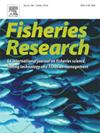Using highest density intervals can reduce perceived uncertainty in stock assessments
IF 2.2
2区 农林科学
Q2 FISHERIES
引用次数: 0
Abstract
Sustainably managed fisheries provide conservation and socio-economic benefits. To set catch quotas, decision makers are guided by stock assessments that use mathematical models to make quantitative predictions of how populations will change under different management scenarios. Stock assessments need to communicate uncertainty of estimated quantities, which is often done through figures and tables depicting credible or confidence intervals. We show that computing such intervals with the usual equal-tailed approach has undesirable consequences, such as excluding highly probable values yet including relatively improbable values. This can give an overly optimistic impression of the health of fish stocks, with potential unexpected management implications. Instead, using highest density intervals can resolve these problems, resulting in narrower intervals that reduce perceived uncertainty (by 3 billion fish for a recent cohort of Pacific Hake, Merluccius productus, for example). Therefore, we recommend consideration of highest density intervals in fisheries applications and other fields to better characterize uncertainty and improve conservation advice. We introduce our new R package, hdiAnalysis, which enhances previous methods to encourage and facilitate uptake by practitioners.
使用最高密度区间可以减少种群评估中的感知不确定性
可持续管理的渔业提供养护和社会经济效益。为了设定捕捞配额,决策者以种群评估为指导,种群评估使用数学模型对种群在不同管理情景下的变化进行定量预测。库存评估需要传达估计数量的不确定性,这通常是通过描绘可信或置信区间的数字和表格来完成的。我们表明,用通常的等尾方法计算这样的间隔会产生不良后果,例如排除高度可能的值,但包括相对不可能的值。这可能给人一种对鱼类种群健康状况过于乐观的印象,并可能带来意想不到的管理影响。相反,使用最高的密度间隔可以解决这些问题,从而产生更窄的间隔,从而减少感知到的不确定性(例如,最近一群太平洋黑鲈(Merluccius productus)减少了30亿条鱼)。因此,我们建议在渔业应用和其他领域考虑最高密度间隔,以更好地表征不确定性并改进保护建议。我们引入了新的R包,hdiAnalysis,它增强了以前的方法,以鼓励和促进从业者的吸收。
本文章由计算机程序翻译,如有差异,请以英文原文为准。
求助全文
约1分钟内获得全文
求助全文
来源期刊

Fisheries Research
农林科学-渔业
CiteScore
4.50
自引率
16.70%
发文量
294
审稿时长
15 weeks
期刊介绍:
This journal provides an international forum for the publication of papers in the areas of fisheries science, fishing technology, fisheries management and relevant socio-economics. The scope covers fisheries in salt, brackish and freshwater systems, and all aspects of associated ecology, environmental aspects of fisheries, and economics. Both theoretical and practical papers are acceptable, including laboratory and field experimental studies relevant to fisheries. Papers on the conservation of exploitable living resources are welcome. Review and Viewpoint articles are also published. As the specified areas inevitably impinge on and interrelate with each other, the approach of the journal is multidisciplinary, and authors are encouraged to emphasise the relevance of their own work to that of other disciplines. The journal is intended for fisheries scientists, biological oceanographers, gear technologists, economists, managers, administrators, policy makers and legislators.
 求助内容:
求助内容: 应助结果提醒方式:
应助结果提醒方式:


